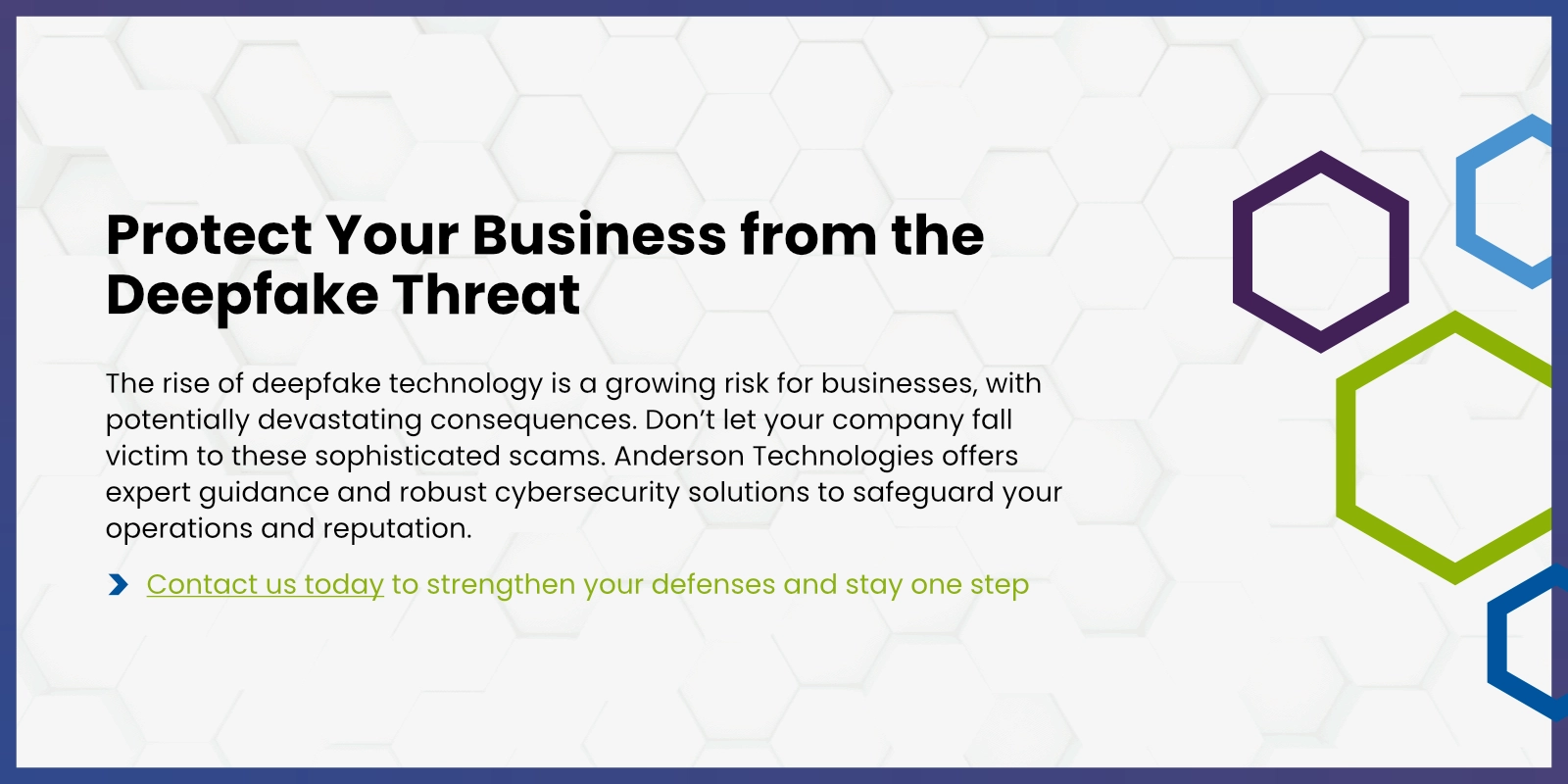
By Principal Farica Chang
If there have been any lasting benefits from the pandemic, better business agility is certainly one of them. Thanks to more reliable, affordable video calling platforms, companies can meet with clients, partners, and providers anywhere in the world without having to set foot outside the office.
Sadly, nothing good ever comes for free, and as we move towards 2025, businesses are facing a new danger made possible by online conferencing. In this blog, we’re diving into the world of deepfake video calls. We’ll examine what they are, why they’re on the rise, and just how much they could cost your business. Stick around to avoid learning a very expensive lesson.
The Lowdown on Deepfakes
A deepfake is a kind of synthetic media created using artificial intelligence, usually machine learning algorithms. By analyzing audio, video, or image data of a person, AI can generate a highly realistic digital imitation. It no longer takes hours of audio and video sourced from social media, websites, and so on, for threat actors to create deepfakes realistic enough to have serious consequences.
In deepfake video calls, cybercriminals use these AI-generated videos or audio clips to impersonate executives, deceive employees, and manipulate corporate transactions. Biometric technology company ID R&D reports that more than 2 in 5 organizations have already encountered a deepfake attack—and that’s just the ones who were aware of it. The reality is that many businesses may have already been targeted without realizing it. If the trend of rapid AI development continues, it’s likely many more will meet the same fate.
What Could It Cost Your Business?
The potential cost of a deepfake attack on your business is multifaceted. A successful deepfake scam could impact your:
-
Data
Cybercriminals may use deepfakes to gain unauthorized access to confidential company data, leading to potential breaches that could expose sensitive information.
-
Reputation
Falling victim to a deepfake scam can severely damage your company’s reputation. Clients, partners, and the public may lose faith in your ability to safeguard sensitive information and transactions.
-
Trust
Trust is a cornerstone of any business relationship. Once eroded, it can be challenging to rebuild, especially if customers feel that their data or interactions with your company are no longer secure.
-
Time and Productivity
Dealing with the aftermath of a deepfake attack can be time-consuming and disruptive, diverting resources away from operations as your team tries to rebuild.
-
Finances
Of course, the most immediate and tangible impact is the potential loss of money. A well-executed deepfake scam can result in significant financial losses, through revenue hits, non-compliance penalties, and even legal fees.
Such was the case with one finance worker in Hong Kong, where the consequences totaled a stomach-churning $25 million—because the ‘Chief Financial Officer’ on the other end of the screen was actually a phony.
The Real-Life Dangers of Deepfakes
Earlier this year, a finance worker at a multinational corporation was duped into attending a meeting with someone who appeared to be the company’s CFO. By the end of the call, the worker had agreed to transfer the equivalent of $25.6 million to five different Hong Kong-based bank accounts. It was only when he double-checked the transaction with the company’s head office a week later that the unfortunate worker realized he’d been scammed.
The warning signs were there: the initial message he’d received mentioned a ‘secret transaction,’ which the worker marked as a likely sign of phishing. But once in the meeting, his doubts were put aside thanks to the presence of several coworkers on the call. Later, these would also all be revealed as deepfakes.
It’s a smart tactic—while a one-to-one with a high-level senior might raise suspicions, when your ‘colleagues’ are also in attendance, there’s far less cause for alarm. We know from conformity psychology that even if the worker had still felt something was off, when seeing his trusted colleagues agreeing with the CFO’s request, he probably would’ve followed suit.
What Lessons Can We Learn?
This case is a stark reminder of the growing security risks for businesses posed by deepfakes. Thankfully, awareness of these threats is on the rise; ID R&D reported that 91% of companies and their customers are worried about deepfake fraud. However, understanding the threat is only the first step. Businesses also must take proactive measures to protect themselves.
The Hong Kong incident shows us the following:
-
No Business Is Immune
Regardless of your company’s size, anyone can be targeted by a deepfake attack. Small and medium-sized businesses (SMBs) are particularly vulnerable because they may lack the robust security infrastructure of larger corporations—though clearly, even the big fish can be reeled in without enough threat awareness.
-
Psychological Manipulation Is Key
Cybercriminals are becoming increasingly adept at using social engineering tactics to pull off successful scams. This case perfectly illustrates how deepfakes can be used to exploit our natural tendencies to trust authority figures and conform to group behavior.
-
Verification Protocols Are Vital
Establishing and enforcing strict verification protocols is crucial. Whether it’s using a verbal safe code, requiring a signed key to be shown by all parties in the call, or asking questions that confirm the identity of the person on the other end, these measures can help prevent successful deepfake scams.
-
Training and Vigilance Should Be a Top Priority
Ensuring your team is trained to recognize the signs of a deepfake and understand the security risks for businesses is probably the most essential step of all. Encourage a culture of vigilance where employees feel comfortable questioning suspicious requests, even from high-level executives.
-
Your Gut Will Rarely Lead You Wrong
Especially once you’re undergoing regular education, if something seems off, it probably is. A quick check-in on another communication channel, such as a phone call or in-person verification, can easily clarify any doubts and prevent pricey mistakes.
Staying Ahead of the Deepfake Threat
The rise of deepfake technology represents a new frontier in cybercrime, one that poses significant security risks for businesses. As deepfakes become more sophisticated and harder to detect, the cost of a deepfake attack can escalate rapidly, impacting not just your bottom line but also your reputation and customer trust.
To stay ahead of this evolving threat, SMBs in St. Louis and elsewhere must adopt a more proactive approach to cybersecurity than ever before. This includes implementing robust verification protocols, investing in employee training, and fostering a culture of vigilance. Additionally, consider leveraging AI-powered threat detection tools that can help identify other advanced cyber threats before they cause harm.
Anderson Technologies: Real People Creating Business-Changing IT Solutions
For over 25 years, Anderson Technologies has leveraged our expertise for the benefit of our clients, supplying them with suitable, secure IT and strategic guidance for their technological future.
We’re a dynamic team of IT professionals with over 200 years of combined experience and specialist certifications to back up our knowledge. As a trusted advisor, we don’t just focus on today. We strive to take your technology light-years ahead of your competition and scale with your business’s success.
Ready to secure your business? Contact us today to get started.



